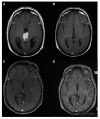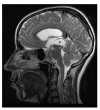Pineal Gland Tumors: A Review
- PMID: 33801639
- PMCID: PMC8036741
- DOI: 10.3390/cancers13071547
Pineal Gland Tumors: A Review
Abstract
The pineal gland is a small, pinecone-shaped endocrine gland that participates in the biological rhythm regulation of vertebrates. The recognized major product of the pineal gland is melatonin-a multifunctional endogenous indoleamine. Accumulating evidence suggests that the pineal gland is important for preserving ideal health conditions in vertebrate. Tumors of the pineal region account for approximately 3-11% of pediatric brain neoplasms but fewer than 1% of brain neoplasms in adults. It is fundamental to expand advanced imaging techniques together with both clinical and laboratory knowledge, to help to differentiate among pineal neoplasms and thus facilitate accurate primary diagnoses and proper therapeutic interventions. In this review, we report the gross anatomy of the pineal gland and its functional significance and discuss the clinical relevance of pineal gland tumors, underlining the importance of identifying the leading causes of pineal region masses.
Keywords: brain neoplasms; pineal germ cell tumors; pineal gland; pineal metastasis; pineal parenchymal tumor.
Conflict of interest statement
The authors declare no conflict of interest.
Figures











Similar articles
-
Biomarkers of Pineal Region Tumors: A Review.Ochsner J. 2019 Spring;19(1):26-31. doi: 10.31486/toj.18.0110. Ochsner J. 2019. PMID: 30983898 Free PMC article. Review.
-
Pineal Gland Tumor but not Pinealoma: A Case Report.Cureus. 2017 Aug 18;9(8):e1576. doi: 10.7759/cureus.1576. Cureus. 2017. PMID: 29057188 Free PMC article.
-
Pineal Region Masses in Pediatric Patients.Neuroimaging Clin N Am. 2017 Feb;27(1):85-97. doi: 10.1016/j.nic.2016.08.002. Neuroimaging Clin N Am. 2017. PMID: 27889025 Review.
-
MRI of pineal region tumors.J Neurooncol. 2001 Sep;54(3):251-61. doi: 10.1023/a:1012773727022. J Neurooncol. 2001. PMID: 11767291 Review.
-
Pineal Gland Cancer.2023 Aug 23. In: StatPearls [Internet]. Treasure Island (FL): StatPearls Publishing; 2025 Jan–. 2023 Aug 23. In: StatPearls [Internet]. Treasure Island (FL): StatPearls Publishing; 2025 Jan–. PMID: 32809402 Free Books & Documents.
Cited by
-
Multiple lessons learned from a single case: Complications from pineal germinoma management.Surg Neurol Int. 2022 Jan 20;13:29. doi: 10.25259/SNI_944_2021. eCollection 2022. Surg Neurol Int. 2022. PMID: 35127229 Free PMC article.
-
Papillary Tumor of the Pineal Region Treated With Surgery and Postoperative Radiotherapy: A Case Report.Cureus. 2025 Jan 25;17(1):e77989. doi: 10.7759/cureus.77989. eCollection 2025 Jan. Cureus. 2025. PMID: 39867506 Free PMC article.
-
Mixed germ cell tumor of the pineal gland in a pediatric patient.Radiol Case Rep. 2022 Jun 17;17(9):2940-2945. doi: 10.1016/j.radcr.2022.05.024. eCollection 2022 Sep. Radiol Case Rep. 2022. PMID: 35755097 Free PMC article.
-
Neuro-otology symptoms as the early sign in pediatric patient with a pineal gland tumor: a case report.Radiol Case Rep. 2022 Jun 23;17(9):3051-3054. doi: 10.1016/j.radcr.2022.06.001. eCollection 2022 Sep. Radiol Case Rep. 2022. PMID: 35789558 Free PMC article.
-
Continuum topological derivative - A novel application tool for segmentation of CT and MRI images.Neuroimage Rep. 2024 Aug 1;4(3):100215. doi: 10.1016/j.ynirp.2024.100215. eCollection 2024 Sep. Neuroimage Rep. 2024. PMID: 40568569 Free PMC article.
References
-
- Moretti R., Zanin A., Pansiot J., Spiri D., Manganozzi L., Kratzer I., Favero G., Vasiljevic A., Rinaldi V.E., Pic I., et al. Melatonin reduces excitotoxic blood-brain barrier breakdown in neonatal rats. Neuroscience. 2015;311:382–397. doi: 10.1016/j.neuroscience.2015.10.044. Erratum in: Neuroscience2016, 315, 296. - DOI - PubMed
Publication types
LinkOut - more resources
Full Text Sources
Other Literature Sources

